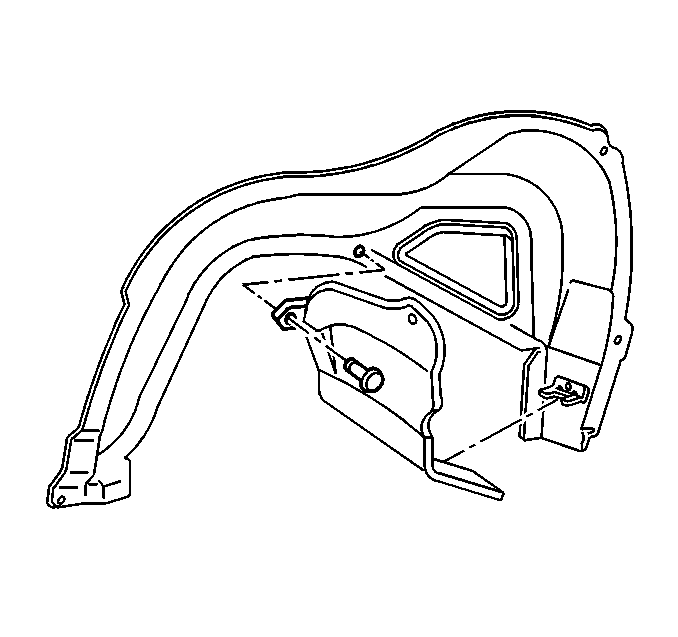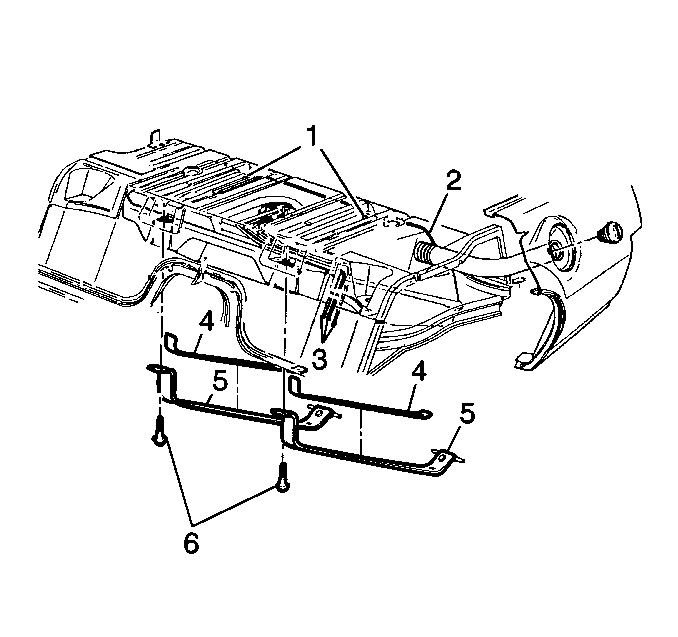Removal Procedure
- Disconnect the negative battery cable.
- Relieve the fuel system pressure. Refer to the Fuel Pressure Relief Procedure .
- Drain the fuel tank. Refer to Fuel Tank Draining .
- Raise the vehicle.
- Remove the fuel filler pipe shield.
- Remove the exhaust system (pipe and muffler).
- Remove the exhaust system heat shields.
- Remove the rear axle assembly. Refer to Rear Axle Housing in the Rear Axle section.
- Clean all fuel pipe and hose connections and surrounding areas before disconnecting in order to avoid possible contamination of the fuel system.
- Disconnect the fuel feed pipe, the fuel return pipe, and EVAP pipe and vent hose at the fuel sender assembly pipes (3). Refer to Servicing Quick Connect Fittings .
- Disconnect the fuel sender electrical connector.
- With the aid of an assistant, support the fuel tank (2).
- Remove the fuel tank strap front attaching bolts (6), the fuel tank straps (5) and the fuel tank.
- Place the fuel tank in a suitable work area.
- Remove the fuel tank insulator pads (1) and the tank strap insulator pads (4).
- Remove the fuel sender assembly from the fuel tank. Refer to Fuel Sender Assembly Replacement .

Caution: Provide additional support when a vehicle is on a hoist in the following
ways:
• Before removing parts, support the opposite end. This helps prevent
the vehicle from slipping off. • Before removing major components, chain the vehicle frame to the
hoist pads at the same end as the removal. This helps avoid a tip-off.

Notice: Do not bend the fuel tank straps. Bending the fuel tank straps may damage the straps.
Installation Procedure
- Install the fuel sender assembly to the fuel tank. Refer to Fuel Sender Assembly Replacement .
- Install the tank strap insulator pads (4) and the fuel tank insulator pads (1).
- Hook the rear ends of the fuel tank straps (5) into the underbody brackets.
- With the aid of an assistant, position and support the fuel tank.
- Position the fuel tank straps (5) and loosely install the front fuel tank strap attaching bolts (6).
- Connect the fuel sender electrical connector.
- Connect the fuel return pipe, the fuel feed pipe, the EVAP pipe, and the vent hose and clamps at the fuel sender assembly pipes (3). Refer to Servicing Quick Connect Fittings .
- Install the rear axle assembly. Refer to Rear Axle Housing in the Rear Axle section.
- Install the exhaust system heat shields and attaching screws.
- Install the exhaust system (pipe and muffler).
- Install the fuel filler pipe shield.
- Lower the vehicle.
- Refill the fuel tank.
- Install the fuel filler cap.
- Connect the negative battery cable.
- Inspect for leaks.

Tighten
Tighten the front fuel tank strap attaching bolts to 33 N·m
(24 lb ft).
Refer to the
Notice: Use the correct fastener in the correct location. Replacement fasteners must be the correct part number for that application. Fasteners requiring replacement or fasteners requiring the use of thread locking compound or sealant are identified in the service procedure. Do not use paints, lubricants, or corrosion inhibitors on fasteners or fastener joint surfaces unless specified. These coatings affect fastener torque and joint clamping force and may damage the fastener. Use the correct tightening sequence and specifications when installing fasteners in order to avoid damage to parts and systems.
in General Information.
| 16.1. | Turn the ignition switch ON for two seconds. |
| 16.2. | Turn the ignition switch OFF for ten seconds. |
| 16.3. | Turn the ignition switch ON. |
| 16.4. | Check for fuel leaks. |
